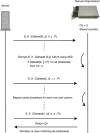Secure management of biomedical data with cryptographic hardware
- PMID: 22010157
- PMCID: PMC4156282
- DOI: 10.1109/TITB.2011.2171701
Secure management of biomedical data with cryptographic hardware
Abstract
The biomedical community is increasingly migrating toward research endeavors that are dependent on large quantities of genomic and clinical data. At the same time, various regulations require that such data be shared beyond the initial collecting organization (e.g., an academic medical center). It is of critical importance to ensure that when such data are shared, as well as managed, it is done so in a manner that upholds the privacy of the corresponding individuals and the overall security of the system. In general, organizations have attempted to achieve these goals through deidentification methods that remove explicitly, and potentially, identifying features (e.g., names, dates, and geocodes). However, a growing number of studies demonstrate that deidentified data can be reidentified to named individuals using simple automated methods. As an alternative, it was shown that biomedical data could be shared, managed, and analyzed through practical cryptographic protocols without revealing the contents of any particular record. Yet, such protocols required the inclusion of multiple third parties, which may not always be feasible in the context of trust or bandwidth constraints. Thus, in this paper, we introduce a framework that removes the need for multiple third parties by collocating services to store and to process sensitive biomedical data through the integration of cryptographic hardware. Within this framework, we define a secure protocol to process genomic data and perform a series of experiments to demonstrate that such an approach can be run in an efficient manner for typical biomedical investigations.
Figures






Similar articles
-
A cryptographic approach to securely share and query genomic sequences.IEEE Trans Inf Technol Biomed. 2008 Sep;12(5):606-17. doi: 10.1109/TITB.2007.908465. IEEE Trans Inf Technol Biomed. 2008. PMID: 18779075
-
Secure construction of k-unlinkable patient records from distributed providers.Artif Intell Med. 2010 Jan;48(1):29-41. doi: 10.1016/j.artmed.2009.09.002. Epub 2009 Oct 28. Artif Intell Med. 2010. PMID: 19875273
-
Record linkage based patient intersection cardinality for rare disease studies using Mainzelliste and secure multi-party computation.J Transl Med. 2022 Oct 8;20(1):458. doi: 10.1186/s12967-022-03671-6. J Transl Med. 2022. PMID: 36209221 Free PMC article.
-
Privacy-Preserving Methods for Feature Engineering Using Blockchain: Review, Evaluation, and Proof of Concept.J Med Internet Res. 2019 Aug 14;21(8):e13600. doi: 10.2196/13600. J Med Internet Res. 2019. PMID: 31414666 Free PMC article. Review.
-
Privacy preserving interactive record linkage (PPIRL).J Am Med Inform Assoc. 2014 Mar-Apr;21(2):212-20. doi: 10.1136/amiajnl-2013-002165. Epub 2013 Nov 7. J Am Med Inform Assoc. 2014. PMID: 24201028 Free PMC article. Review.
Cited by
-
Volumetric Light-field Encryption at the Microscopic Scale.Sci Rep. 2017 Jan 6;7:40113. doi: 10.1038/srep40113. Sci Rep. 2017. PMID: 28059149 Free PMC article.
-
PRINCESS: Privacy-protecting Rare disease International Network Collaboration via Encryption through Software guard extensionS.Bioinformatics. 2017 Mar 15;33(6):871-878. doi: 10.1093/bioinformatics/btw758. Bioinformatics. 2017. PMID: 28065902 Free PMC article.
-
A secure SNP panel scheme using homomorphically encrypted K-mers without SNP calling on the user side.BMC Genomics. 2019 Apr 4;20(Suppl 2):188. doi: 10.1186/s12864-019-5473-z. BMC Genomics. 2019. PMID: 30967116 Free PMC article.
-
Routes for breaching and protecting genetic privacy.Nat Rev Genet. 2014 Jun;15(6):409-21. doi: 10.1038/nrg3723. Epub 2014 May 8. Nat Rev Genet. 2014. PMID: 24805122 Free PMC article. Review.
-
Private and Efficient Query Processing on Outsourced Genomic Databases.IEEE J Biomed Health Inform. 2017 Sep;21(5):1466-1472. doi: 10.1109/JBHI.2016.2625299. Epub 2016 Nov 4. IEEE J Biomed Health Inform. 2017. PMID: 27834660 Free PMC article.
References
-
- Khoury M, Rich EC, Randhawa G, Teutsch S, Niederhuber J. Comparative effectiveness research and genomic medicine: An evolving partnership for 21st century medicine. Genet Med. 2009;11(10):707–711. - PubMed
-
- Green E, Guyer M, National Human Genome Research Institute Charting a course for genomic medicine from base pairs to bedside. Nature Genet. 2011;470:204–213. - PubMed
-
- Gurwitz D, Lunshof J, Altman R. A call for the creation of personalized medicine databases. Nature Rev Drug Discov. 2006;5(1):23–26. - PubMed
-
- National Institutes of Health. Policy for sharing of data obtained in NIH supported or conducted genome-wide association studies (GWAS) 2007 Aug; NOT-OD-07-088.
Publication types
MeSH terms
Grants and funding
LinkOut - more resources
Full Text Sources
Other Literature Sources
Research Materials

